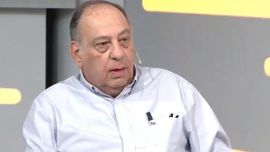The death of special prosecutor Alberto Nisman and the underlying lack of justice for the victims of the brutal 1994 terrorist attack against the AMIA Jewish community centre in Buenos Aires are once again centre-stage, after the recent release of a new Netflix documentary, Nisman: The Prosecutor, The President and the Spy.
The documentary lays bare the incapacity of the Argentine judicial system to effectively pursue an investigation, coupled with the direct influence of foreign powers in Argentina, starting with the attack, going through who the supposed perpetrators are, and finally ending with Nisman’s mysterious death, which happened five years ago next Saturday.
Like a Russian doll, the 1992 bombing of the Israeli Embassy in Buenos Aires and the 1994 explosion at the AMIA community centre created a series of offshoot hypotheses and judicial investigations that have ultimately ended up drawing more attention than the original investigation. Unfortunately, today it seems more relevant to figure out whether Nisman killed himself or was the victim of a highly professional attack, rather than figuring out why terrorists chose the AMIA in Buenos Aires and who ordered them to do it.
Beginning, therefore, with Nisman’s death, it is clear that in the five years since that Bersa Thunder .22-calibre handgun shot that fateful bullet into the special prosecutor’s head, rather than coming to a certain agreement about what basically happened, the whole case has become intoxicated with the nefarious grieta. Whether Nisman’s accusation against Cristina Fernández de Kirchner, Héctor Timerman, and others for allegedly trying to grant Iranian officials immunity in exchange for funds is valid or not depends mainly on one’s political position. The same thing can be said about people’s opinions regarding his death.
The most basic details regarding his demise have become the centre of an ideological conflict that should instead be purely criminalistic and scientific. The initial investigation, carried out by prosecutor Viviana Fein, indicated it had no evidence to suggest anyone else was in the bathroom of the Le Parc tower apartment along with Nisman when he died, relying on an investigation by the Supreme Court’s Forensic Medical Unit. A later investigation, paid for by Nisman’s ex-wife, federal judge Sandra Arroyo Salgado, concluded that Nisman was effectively murdered by someone else while kneeling, and that his body had been moved after the fact. In that investigation, Arroyo Salgado counted on Argentine’s foremost expert in forensic analysis, Osvaldo Ruffo, who in early 2019 took his own life due to physical ailments.
Those conclusions were echoed by a later report put together by the Border Guard, or Gendarmerie. Their Criminalistics and Forensics Study Division, led by Major Commander Orlando Livio Caballero, concluded that Nisman was subdued by two individuals who then drugged him with ketamine and ultimately murdered him. Judge Julián Ercolini, prosecutor Eduardo Taiano, and the Buenos Aires Federal Appeals Court have all acknowledged this last report. Yet, President Alberto Fernández has already described it as “lacking of any scientific rigour,” with his newly minted security minister, Sabrina Frederic, indicating that they will launch an internal investigation into that process and suggesting it was politically motivated. Interestingly, in the Netflix documentary, and in previous TV appearances when he was actively critical of his current vice-president, Fernández had cast doubt over Nisman’s potential suicide, while claiming the Memorandum with Iran — which was the root of Nisman’s accusation against Mrs. Fernández de Kirchner — would be one of the then-president’s biggest mistakes.
Another situation that hasn’t been clarified has to do with some 4,500 phone calls that occurred in the days and hours immediately before Nisman’s death. These, which have just been introduced into the case, according to Clarín, supposedly show a flurry of activity between members of the intelligence agencies and officials from th national, provincial, and City governments, including then-president Cristina. They took place at the same time in which Nisman was trying to communicate with super-spy Antonio “Jaime” Stiuso, one of the documentary’s protagonists. It is interesting that while Stiuso is such a difficult character to pursue journalistically in Argentina, a simple call to participate in a Netflix documentary sees him immediately sit in front of a camera for a full-on interview. The power of Hollywood, or perhaps Silicon Valley.
Why Stiuso, who is considered the mastermind behind the intelligence services and the hypotheses that Nisman used to build his case, never answered the special prosecutor’s calls on that fateful Sunday evening is a question we will never be able to answer. In the documentary, he claims his phone was on “silent mode,” but that he wouldn’t have answered anyways so as not to harm Nisman and his public accusation against Cristina. Yet, another dark character, Allan Bogado, claims Stiuso was in constant communication with Alberto Mazzino, who in turn was in constant communication with Nisman. Mazzino was one of the heads of the SIDE spy agency, while Bogado is a supposed “inorganic agent” whom Nisman had accused of collaborating with the Fernández de Kirchner administration, in order to favour Iran regarding the AMIA investigation.
While there are many more doubts regarding how Nisman actually died, his underlying investigation has also been called into question. The special prosecutor was convinced Iran was behind the dual attacks on the Israeli Embassy and the AMIA community centre, which he believed were executed through Hezbollah. It was a response to the breaking down of a deal in which Argentina would share nuclear technology with Iran. This was the hypothesis Stiuso formulated, in conjunction with foreign intelligence agencies, suggesting that the 21-year-old Lebanese, Ibrahim Hussein Berro, drove the Renault Trafic minivan charged with explosives in the AMIA attack. Both Hezbollah and Berro’s family members deny this though, claiming he was killed in battle against Israeli security forces, which is the information that appears in the official court documents put together by Nisman. Furthermore, DNA tests conducted by the FBI, which had proved Berro’s participation — confirmed by a former FBI agent on camera for the documentary — were never part of the docket, and they are currently non-existent, according to the FBI.
Not only is it unclear who was the actual perpetrator, US officials also admit that they had no real evidence that Iran was behind the attacks, only that Hezbollah was. In the early stages of the investigation there was a “Syrian connection” which was never investigated in detail. And, of course, there was the actual cover-up of the case in Argentina, for which former federal judge Juan José Galeano was ultimately convicted. What is clear is that Nisman and Stiuso were both receiving information from US intelligence agencies, which helped form the basis of the accusations.
Too many moving parts and very little to show for, five years after Nisman’s death and more than 25 years after the attacks.




















Comments